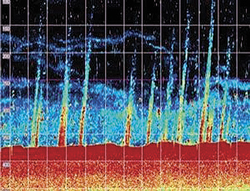Vol. 233 No. 7
EPA: Go after Mother Nature
|
.jpg)
|
The U.S. Environmental Protection Agency (EPA) has been enforcing the Clean Air Act with extraordinary zeal that is typical of a religious crusade. The law was passed in 1970, but under President Barack Obama, its mandates and rules have escalated, particularly for the administration’s stepchild, the oil and gas industry.
On April 17, the EPA turned its sights on natural gas producers through the first federal air standards for natural gas wells. These rules will apply to the 11,400 new wells that are fractured each year and another 1,400 existing wells that are re-fractured, according to EPA estimates. The rules will apply in two phases. Until Jan. 1, 2015, the industry must reduce volatile organic compounds (VOCs), either by flaring with a completion combustion device or by capturing the gas using a reduced emission completion (REC), or as it is termed, a “green” completion. After Jan. 1, 2015, the operators must capture the gas through a green completion.
The EPA estimates that green completions will reduce VOC emissions by 95% from each fractured well. The requirement for additional completion equipment and extensive reporting paperwork comes at a time when shale operators are “losing their shirts,” due to depressed natural gas prices. That’s the comment from ExxonMobil CEO Rex Tillerson.
Nevertheless, several operators are implementing green completions through their participation in the EPA’s Natural Gas STAR program by using truck-mounted RECs that can be shifted from one well location to another. For the three- to 10-day flowback period, the wellhead water line is connected to the REC, which consists of a sand trap, followed by a separator that extracts the gas and condensates, which can be transferred to sales lines. Using RECs makes environmental and economic sense, so the industry would have adapted to the new technology without an EPA mandate and its associated bureaucracy and paperwork.
If the EPA were interested in making a significant impact on GHGs, it should confront the main culprit—Mother Nature. Research scientists have discovered giant methane plumes bubbling to the surface in the Arctic Ocean. EPA rulemakers should leave their air-conditioned comfort in Washington D.C. to join the Arctic expeditions to get a firsthand look at the havoc Mother Nature is causing with methane releases that are 20 times more potent for global warming than CO2.
 |
| Sonar image of methane plumes rising from the Arctic Ocean floor. Source: National Oceanography Centre, Southampton. |
|
In an interview with the UK’s Independent newspaper, Igor Semiletov, the lead scientist for the 8th joint U.S.-Russia cruise of the East Siberian Arctic seas, said that he has never before witnessed the scale and force of the methane being released from the Arctic seabed. “We’ve found continuous, powerful and impressive seeping structures more than 1,000 meters in diameter. It’s amazing,” Dr Semiletov said.
Dr Semiletov’s team published a study in 2010, which estimated that methane emissions from the Arctic were in the region of 8 million tons per year, but the latest expedition suggests that this could be a significant underestimate of the true scale.
There you go, EPA. Ask Mother Nature to plug the Arctic leaks and send an annual report on her progress. Once Mother Nature is in compliance, you can go after another leading cause of methane emissions—cows and bulls grazing on America’s pastures. I am not sure if the bovines will be in a mood to comply. Contributions from API extern Christina Wang of Westside High School, Houston. 
|

.jpg)


